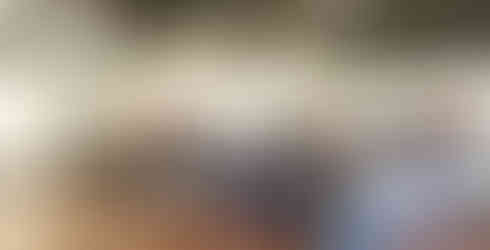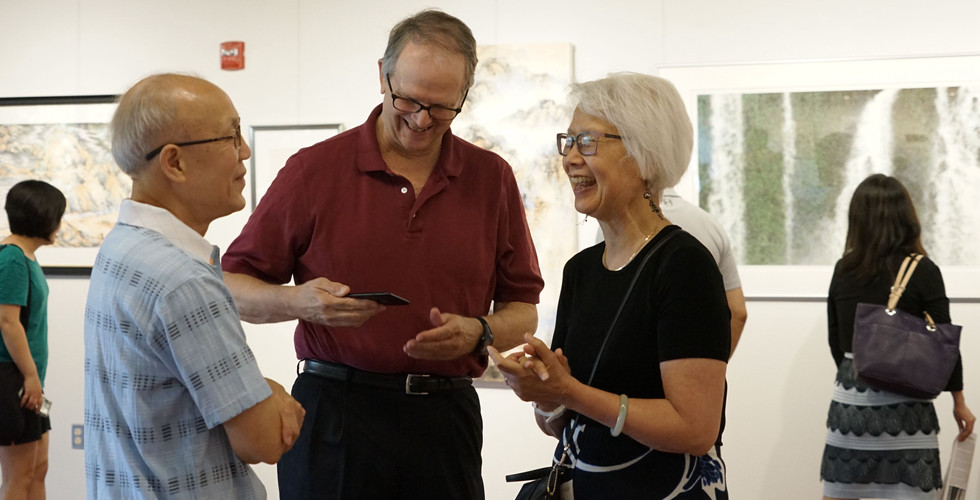Immersed in Art
- Aug 31, 2019
- 5 min read
Updated: Aug 22, 2023
August 31 - September 27, 2019
CCACC Art Gallery held the group exhibition, entitled "Immersed in Art", exhibiting 36 artworks by the members of CCACC Art Club of Ink Paintings and Calligraphy, and Chinese Landscape Painting Class at the Art Club.
Exhibition Artwork
Kit-Keung Kan, Instructor, 靳杰强導師 作品
Falling Water CI 瀑流 一 O 一
題詩 Inscribed poem
太古班芙雪 The snow and ice from the ancient eras
冰融注瀑泉 Melt to feed the waterfall.
傾洋破壁下 It clashes down to crack the cliff like the ocean is tipped,
狂舞到君前 And dances fervently towards you, my dear!

Falling Water CVII 瀑流 一O七
題詩 Inscribed poem
清泉各有姿 The waterfalls are beautiful in all different ways.
或叠或如絲 Some are cascades and others, strands of silk.
坐此幽崖底 As I sat at the bottom of this secluded cliff,
寛襟打稿時 It's the time to loosen my collar and sketch.

"Wish to go to South Ocean and ride on the whales"「欲濟南溟駕巨鯨」in cursive script 草書

"Immersed in Art" 「游于藝」in clerical script 隸書

Freda Lee-McCann, Instructor 李澄華導師 作品
Whisper of the Past 遠代的細語

Cloudy 雲海

Nellie Chao 梁耐妮 作品
Sierra Sundown 高山晚霞
Honorable Mention

Over the Rainbow 彩虹之上
Honorable Mention

Shufan Cheng 鄭夙芬 作品
Magnificent Eagle 昊鷹
Calligraphy in standard script 楷書
Honorable Mention

Esther Chow 周顔玲 作品
Autumn Woods 秋林
Honorable Mention

Web of Rivers 萬派奔江
Honorable Mention

Joanne Dai 林佩珍 作品
Lotus Pond 在水一方
Honorable Mention

Mountain Scenery 江山風月
Honorable Mention

Chanwei Jian 簡闡微 作品
Landscape 山水
Honorable Mention

Looking Forward To 憧憬
Calligraphy in cursive script 草書

Yuen-Han Kan 甘潤嫻 作品
Little Village Above the Clouds 雲外小村

Traveling Beyond the Mountains,「客路青山外,行舟緑水前」
Quote from a poem by Wang Wan 王灣詩句 in cursive script 草書

Richard Kaufman 昂凱 作品
Blue Landscape 青崖小村

Krystal Lai 勵寒冰 作品
Village in the Mountain 山間村落

Follow your Instincts 狂来論劍、醉去吟詩
Calligraphy in standard script 楷書

Vivian Lam 朱雁瑜 作品
A Walk in the Woods 林中漫步

Landscape after Shen Chou 臨沈周山水畫

Tzee-Nan K. Lo 郭子南 作品
“Be Tranquil and Non-active”「 清静無為」in clerical script 隸書

Jiamo Lu 魯嘉模 作品
“Hold on, Think and Speak”「容止若思言辭安定」in cursive script 草書
Honorable Mention

Frances Luk 譚煥芬 作品
Landscape after Chen Duo 臨明陳鐸水閣讀書圖

Suet Man 文雪貞 作品
Landscape 山水

Li-Wen Quach 王麗文 作品
Singing in Spring 歡唱春天

Downstream–Social 水下交流

Mary Wen 文梅元 作品
The Narrows at Zion 錫安狭道

Anne Wong 黃佩珍 作品
“Guest Dust” 「客塵」in semi-cursive script 行書
Guest Dust is a Dharma terminology. It is often used to describe all kinds of troubles.
客塵: 佛教語。指塵世的種種煩惱。
Honorable Mention

Wendy Wu 吳婉玲 作品
View from Swiss Chalet 瑞士小築窗景

First Love 初戀

Wei Xiao 蕭偉 作品
Springs Running to the Falls 千泉注瀑

Sparse Forest 疏林傲立

Shauman Yu 何秀文 作品
Landscape 水墨山水

Life in the Mountain 山居秋暝
Translation of the phrase: After the shower in the Mountain, the evening becomes much cooler. While the moon is shedding upon the pine trees, the spring is flowing on the rocks.

Our Reception
CCACC Art Club of Chinese Painting and Calligraphy
Dr. Kit-Keung Kan, Instructor 靳杰強 導師
Established and headed by volunteer instructor Kit-Keung Kan, the Art Club is for artists who wish to further their success in Chinese painting and calligraphy, and for people who have no previous learning experience, but like to try their hands on this unique art form of the East. The club set out to achieve these goals by holding classes that treat the fundamentals and advanced techniques in these are genres.
The calligraphy classes are directed by Kit-Keung Kan who teaches all of the five major scripts, i.e. the seal 篆, scribe 隸, cursive 草, standard 楷 and semi-cursive 行 scripts. In paintings, Kan and another noted painter, Freda Lee-McCann李澄華direct the class to study Landscape painting through example of old masters. In the past, the club studied paintings by 范寬、郭熙、夏圭、吳鎮、黃公望、文徵明、陳淳、石濤、石谿、弘仁、朱耷、龔賢、張大千、傳抱石、王己千.... etc. From their work the basic techniques, like the bone method of strokes, Cun texturing, composition and aesthetic concepts are studied and discussed. The instructors also conduct outdoor sketch sessions after the students grasped the basic techniques. Artistic development of individual students is emphasized.
Since the club was established in CCACC sixteen years ago, many of our members have held exhibitions, participated in open competitions, won distinguished prizes, served the community by holding demos and workshops. The club shows the members' work in CCACC annual Lunar New Year celebrations every year and arranges public exhibitions once in a few years.
The exhibition is the third comprehensive and public exhibition for the club. Special thank are extended to our juror Mr. Jianjun Zhong President of Lanting Association of Painting, Guangzhou, China, who helped selecting the artworks and the honorable mentioned pieces in this show.
Chinese Landscape Painting Class at the Art Club
Freda Lee-McCann, Instructor 李澄華 導師
The CCACC Art Club is a class in which students of all levels can learn to both appreciate and to actually do Chinese Landscape painting. Our goal is to expose the students to classical landscape paintings by masters whose works date from the Southern Sung dynasty (ca. 1100 AD) to the present.
The essential elements in the study of Chinese landscape painting are very different from Western landscape painting, since Chinese painting is derived from calligraphy. The lines made by brushes on rice paper and the usage of ink are the absolute essential; unlike Western painting for which colors and perspective are the primary ingredients.
In Chinese landscape painting there is no perspective or vanishing point concept; so, one has to create movement in the painting and invite the viewers on a journey to the inner world of the artist’s mind. The paintings are not about the “true” appearance of nature but, rather, the “spirit” of it. The three-dimensional illusion is not formed by static shapes and forms in the same way as in “Western painting; instead, it is created by the apparent movement of the forms with light and shadows that result from multiple light sources, which, in truth, lead the eye through the painting.
Some of the differences between Chinese landscape paintings and Western paintings are: colors and perspective are not as important as in the Western paintings – as a result composition is much more important in Chinese painting; positive and negative spaces are equally important. Further, the placement of the forms in a painting depicts the distance from the viewer, rather than perspective.
The way to read a Chinese landscape painting is to start at eh bottom of a vertical painting. The eye is led through the painting from the bottom and eventually to the top. Students learn by watching the teachers demonstrate and by watching the teachers demonstrate and by copying the works of masters who developed this way of seeing and painting, and passed it down through many generations.






































Comments